Original author: Dingdong, Planet Daily
As Bitcoin breaks through $120,000 and Ethereum regains $3,400, discussions about the return of altcoin season are gradually heating up.
Whether the altcoin season has truly arrived remains uncertain, but if a new round of capital inflow cycles begins, what investment opportunities should we focus on? This article discusses five golden tracks: asset reserves, ETF candidates, RWA, DeFi, and stablecoins, from a subjective perspective. The projects mentioned in this article are not short-term speculative targets, but are based on current market trends; the author believes they may attract more structural attention in the future. The cryptocurrency market is highly volatile, with risks and opportunities coexisting, so investments should remain rational and based on independent judgment. This article is for reference only and does not constitute any investment advice.
How is this round of 'altcoin season' different from the past?
In the past, when mentioning 'altcoin season', the images that often came to mind were the successive rises of sectors, where small and medium-cap coins rose far more than Bitcoin. However, this time, the dominant market logic may be different.
Firstly, there have been significant changes in the macro environment. With the Genius Act and CLARITY Act making breakthrough progress, regulatory boundaries are becoming clearer, and the entry barriers for traditional financial institutions are being eliminated. Unlike the previous 'barbaric growth' driven by retail investors and speculative sentiment, the participation of institutional capital will change the attribution of market pricing power. Their capital scales are much larger, their investment logic is more rigorous, placing greater emphasis on compliance and fundamentals, and they possess stronger market discourse power. This suggests that fields capable of attracting large institutional capital are likely to become market hotspots.
This point has revealed a clear differentiation in the current market trend. Although Bitcoin prices have reached historical highs, most altcoins have generally seen price recoveries of less than 50% since their sharp declines at the beginning of the year, with some even below 30%. Market liquidity continues to concentrate on Bitcoin, while the liquidity of altcoins has significantly tightened. The driving forces behind this differentiation mainly come from two aspects:
1. Institutional drive of Bitcoin spot ETFs
The liquidity trend of Bitcoin spot ETFs clearly reflects the profound impact of institutions on the market. Data indicates that the large-scale net inflow of Bitcoin spot ETFs is basically synchronized with the three-stage structured rise of Bitcoin, indicating that institutional capital has become an important driving force behind Bitcoin price trends.
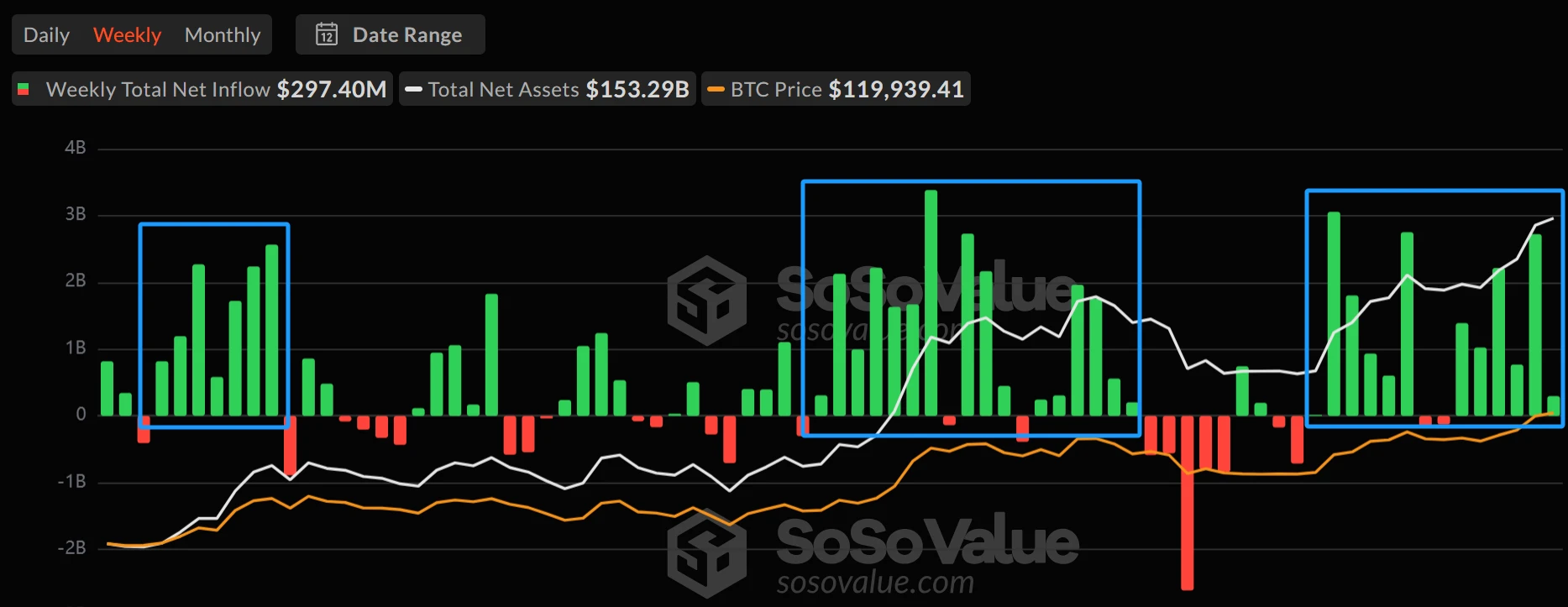
Net inflow and outflow of Bitcoin spot ETF
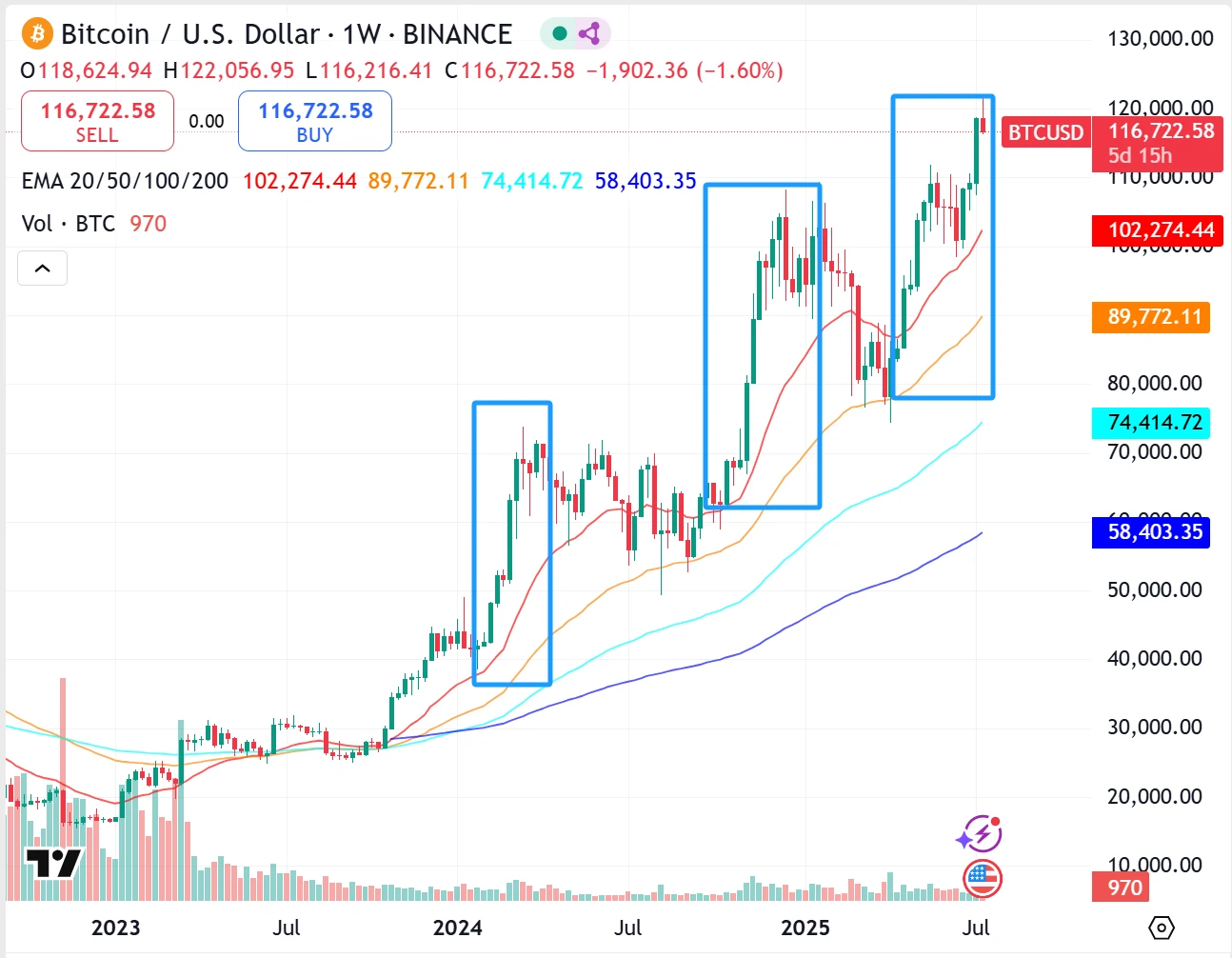
Bitcoin price trend (weekly)
2. The siphon effect of listed companies hoarding coins
The accelerated accumulation of Bitcoin by listed companies in the US has further amplified the capital siphoning effect. On one hand, the increase in Bitcoin holdings by listed companies has directly raised market demand and strengthened the narrative of Bitcoin's scarcity; on the other hand, hoarding behavior has become a 'traffic password' attracting market attention, driving up the stock prices of related companies. In the past six months, the speed at which listed companies have increased their Bitcoin holdings has significantly accelerated, with a holding increase of up to 40%. As of July 2025, the total amount of Bitcoin held by listed companies is approximately 673,000, accounting for 3.2% of the total Bitcoin supply. Among them, Strategy company holds a unique 2.8% share.
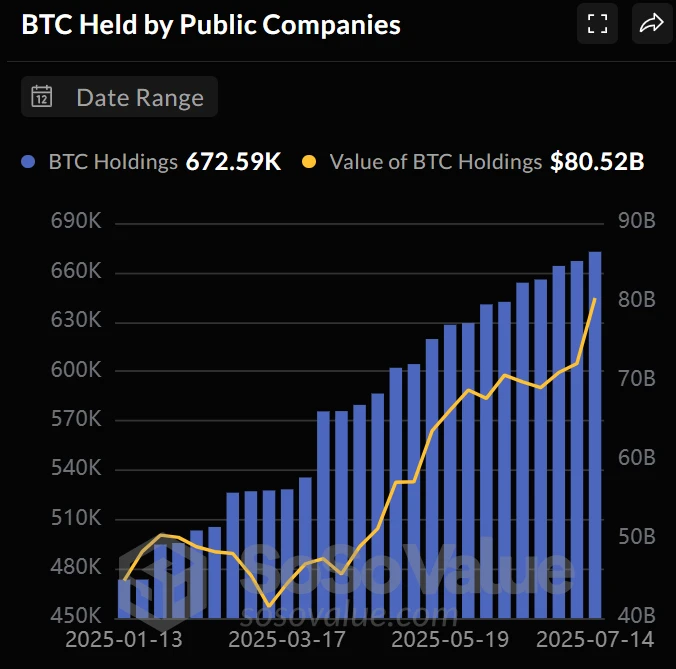
Trends in listed companies' Bitcoin holdings
Looking at Ethereum, its recent rise also demonstrates a trend dominated by institutional capital. First, Ethereum spot ETFs have seen nine weeks of net inflow, with total holdings reaching $13.4 billion, completely reversing the previous downturn of Ethereum.
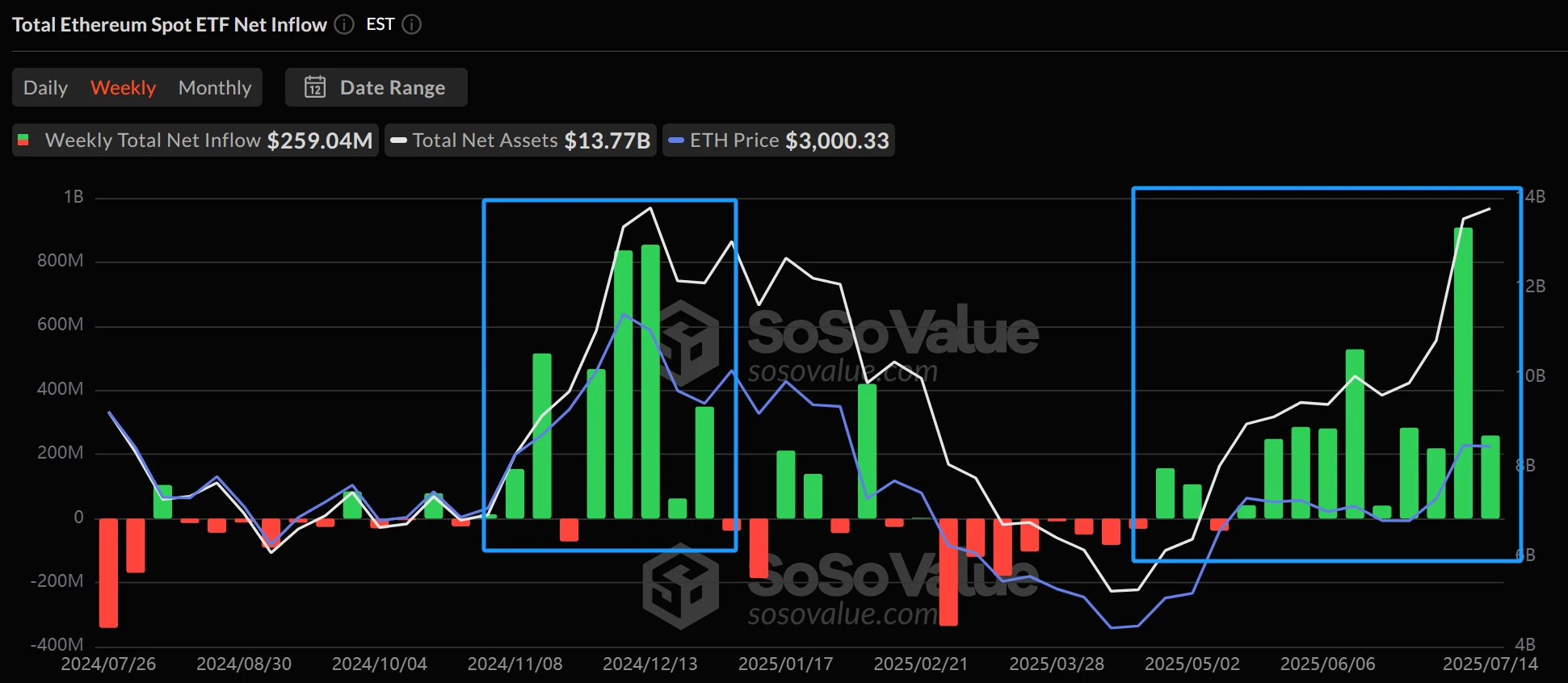
Net inflow and outflow of Ethereum spot ETF
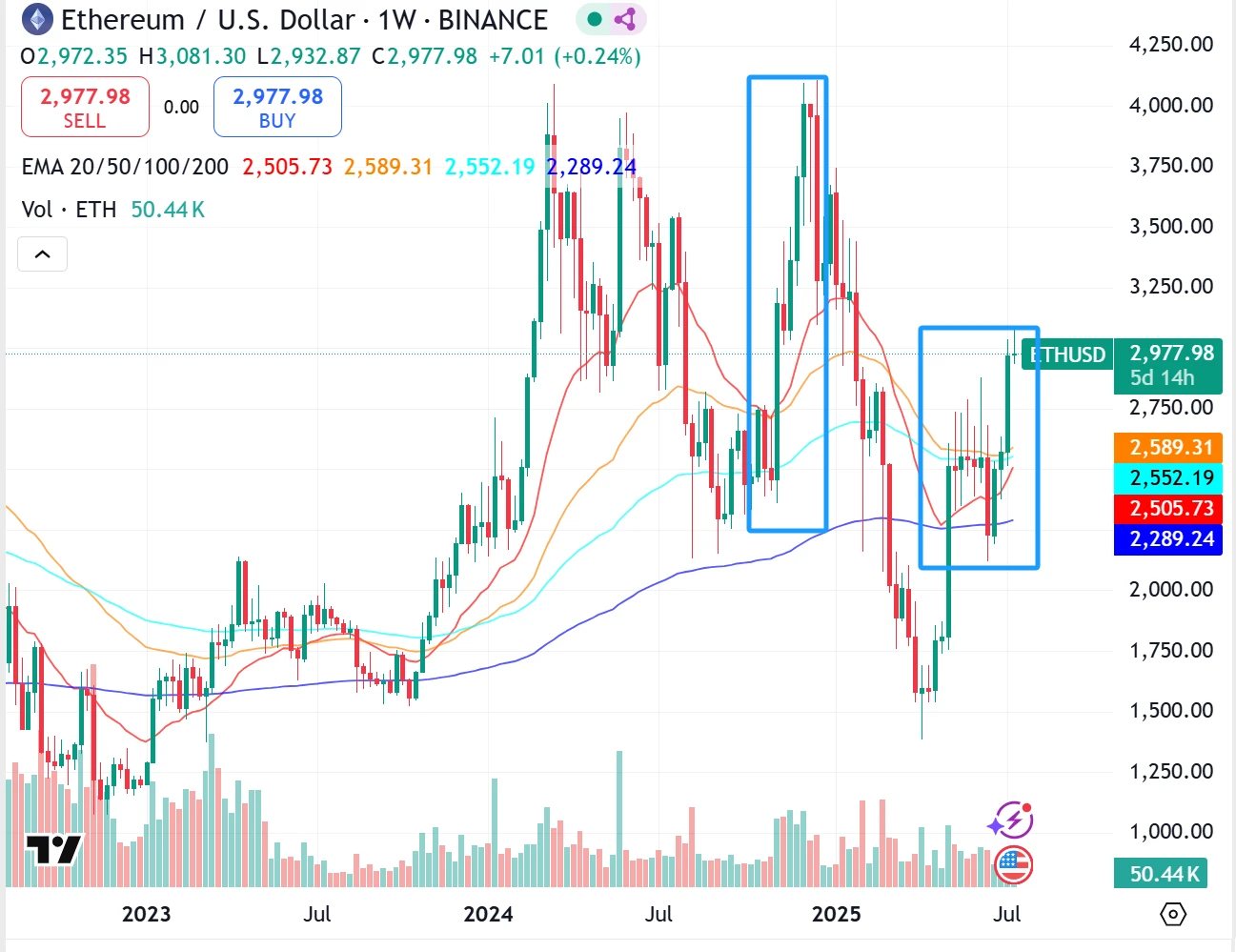
Ethereum price trend (weekly)
Furthermore, a new narrative is forming around Ethereum as an asset reserve. Since SharpLink Gaming first announced the incorporation of ETH into asset reserves, several listed companies such as Bitmine Immersion, Bit Digital, and BTCS have followed suit. Currently, Ethereum reserves held by listed companies account for 9.6% of the total ETH supply, with SharpLink Gaming alone holding 3%, surpassing the Ethereum Foundation and becoming the largest holder, and is still continuously increasing its holdings.
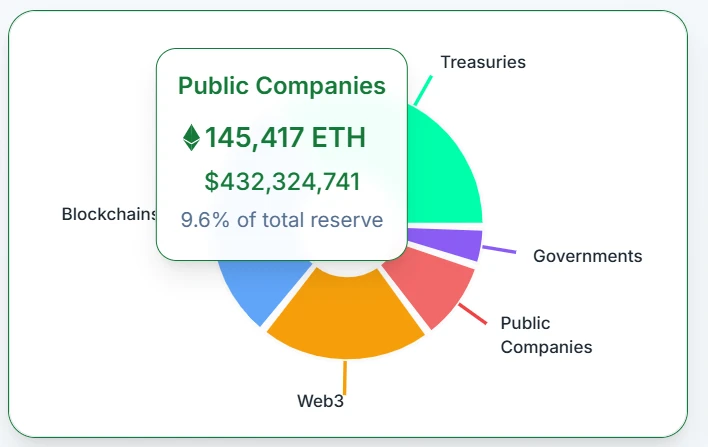
Proportion of Ethereum holdings in listed companies
This trend indicates that Ethereum's narrative as an institutional asset reserve is rapidly heating up. The endorsement from institutional capital has shifted Ethereum's market positioning from a purely 'technical asset' to a dual role of 'value storage' and 'technological empowerment'.
From Bitcoin to Ethereum, all point to a core trend: where institutional capital is, there the market hotspots will be. This means that if this round of 'altcoin season' begins, it may be more driven by institutional capital rather than traditional sector rotation or speculative frenzy. In other words, sectors that can accommodate large amounts of capital or those where institutional capital overflows may be more attractive. Moreover, the participation of institutional capital not only brings more stable capital flows but may also drive the market towards a more mature and rational direction.
It should be noted that the tokens recommended in this article are primarily large-cap projects, as they better align with the preferences of institutional investors. These projects have typically undergone multiple market cycles, have strong fundamental support and a user base, and align with institutional preferences for long-term value. Moreover, institutional investors are constrained by strict compliance requirements, and large-cap tokens, due to their higher market transparency and broad recognition, are more likely to pass regulatory scrutiny, having 'compliance advantages'. This causes institutions to prefer such tokens while avoiding smaller-cap projects that are more speculative in nature.
Although large-cap tokens have advantages in institutional trends, the crypto market is filled with uncertainty. Changes in macroeconomic conditions, regulatory policies, or market sentiment may all affect the flow of funds. Investors should remain cautious and comprehensively assess opportunities and risks through independent research, making rational investment decisions.
Asset reserve track: Which coins can go on corporate balance sheets?
Based on the trends of Bitcoin and Ethereum, tokens incorporated into corporate balance sheets are more likely to become an important investment direction in this round of 'altcoin season'. Currently, listed companies have included some mainstream altcoins in their asset reserves, including BNB, SOL, TRX, and HYPE; further reading reference (US crypto frenzy escalates, 'Altcoin Summer'行情爆发在即).
BNB: As the core of the Binance ecosystem, BNB has strong cash flow support backed by the world's largest exchange in terms of trading volume. Binance recently announced a settlement with US regulators, further solidifying its compliance status.
SOL: Solana is known for its high-performance blockchain and has a strong advantage in Meme trading with a relatively complete ecosystem. In 2024, the Solana Foundation collaborated with several traditional financial institutions to explore RWA (Real World Assets) tokenization, attracting the attention of institutional capital. Recently, the rise of Letsbonk.fun has driven a surge in Solana trading volume, indicating a continuous increase in ecological activity. The approval of the SOL spot staking ETF may provide some reference for the launch of spot SOL ETFs, but specific progress still needs to be observed in market and regulatory dynamics.
TRX: Tron (TRON) attracts a large number of stablecoin transactions through low costs and high throughput, with USDT accounting for over 50% on the TRON chain. At the beginning of 2025, Tron announced collaboration with a Hong Kong fintech company to explore compliant stablecoin applications. By partnering with NASDAQ-listed SRM Entertainment (referred to as SRM) for a reverse merger to achieve listing on the US mainstream capital market.
HYPE: Unlike the aforementioned three assets that have undergone multiple market cycles, HYPE, as an emerging public chain token, has topped the on-chain contract throne due to its continuously rising derivatives trading volume, making it one of the few new projects to demonstrate 'cash flow capability' at an early stage. More detailed data will be provided in the DeFi section below.
Recommendation reasons
Selecting the best from the best, from my personal perspective, although the above are mostly large-cap projects, the core motivation for investors to chase altcoins lies in the expectation that their increases will surpass Bitcoin. From a price elasticity perspective, SOL has performed the weakest in this price recovery cycle, with a relatively loose chip structure. Therefore, under the premise that fundamentals remain intact, once market funds flow back, the price elasticity of SOL may be more pronounced.
In the crypto circle, there is a saying 'buy new, not old'; HYPE, as an emerging project, has a short lifecycle, but may have more 'growth dividends' in the new cycle.
From a long-term perspective, tokens that appear on corporate balance sheets will be part of the 'institutional mainline' in the crypto market. It is worth continuously tracking tokens that may be incorporated into corporate balance sheets in the future.
ETF candidate track: Which altcoins can institutions invest in?
Since the US approved spot ETFs in January 2024, the total net asset value of Bitcoin spot ETFs has exceeded $149.6 billion, and the total net asset value of Ethereum spot ETFs has reached $14.2 billion since their approval in 2024. ETFs are an important channel for institutional capital entry and are becoming an important narrative for altcoins. Potential ETF candidate tokens include: SOL, XRP, LTC, DOGE, ADA, DOT, HBAR, AXL, APT; further reading reference (Altcoin ETF applications pile up, is the ETF 2.0 era coming?).
These tokens are mostly large-cap public chain tokens. Although some tokens have functions limited to trading mediums or units of account and have gradually faded from market focus in the past, since the end of 2024, positive news related to ETFs has caused them to regain institutional and market attention.
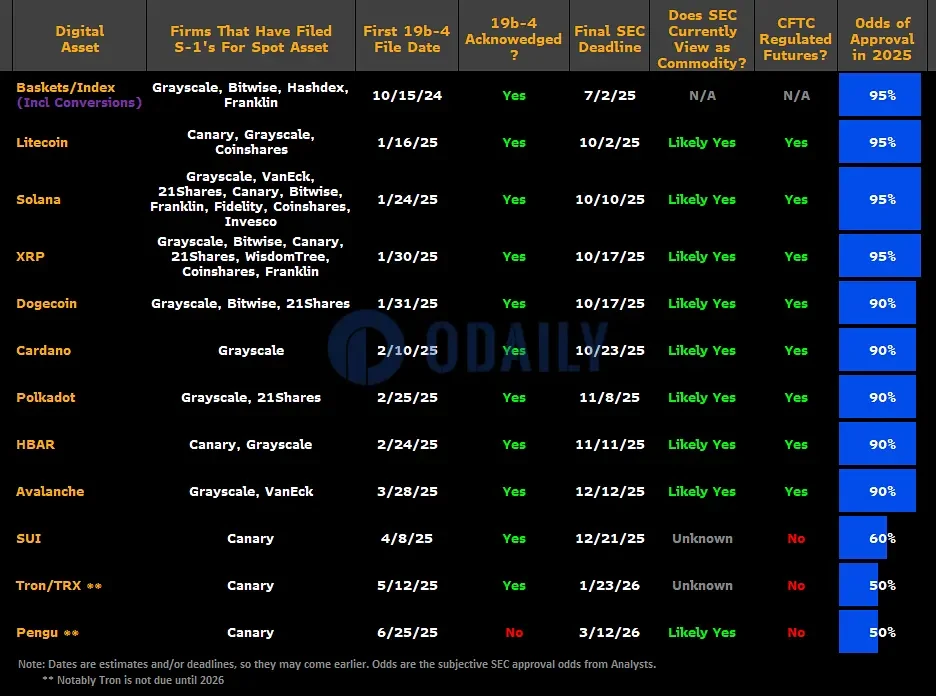
Probability chart for altcoin ETF approvals
Solana (SOL) is the first to emerge in the altcoin ETF track. On June 30, the Solana spot staking ETF applied for by REX-Osprey was approved. However, according to the issuer, the fund's C-Corp (ordinary C corporation) structure allows it to hold spot SOL and stake on-chain to generate returns that are incorporated into fund assets, but this means the ETF does not enjoy the tax-exempt status of ETF funds and must pay income tax at the company level. Therefore, it is not the same as ETFs applied for by VanEck, 21 Shares, Bitwise, etc.
Recommendation reasons
If a traditional spot SOL ETF is approved in the future, it may further strengthen its market attractiveness, which has been recommended in the previous discussion. A similar situation applies to XRP, as the New York Stock Exchange has already approved ProShares Ultra's futures-based XRP ETF, and the long-standing regulatory dispute between Ripple Labs and the US SEC may soon be resolved, making it highly probable that the SEC will approve an XRP spot ETF this year. Moreover, from XRP's price trends, it has consistently maintained a strong defensive position during multiple market corrections. The strong continue to prevail, which has always been well validated in the crypto space.
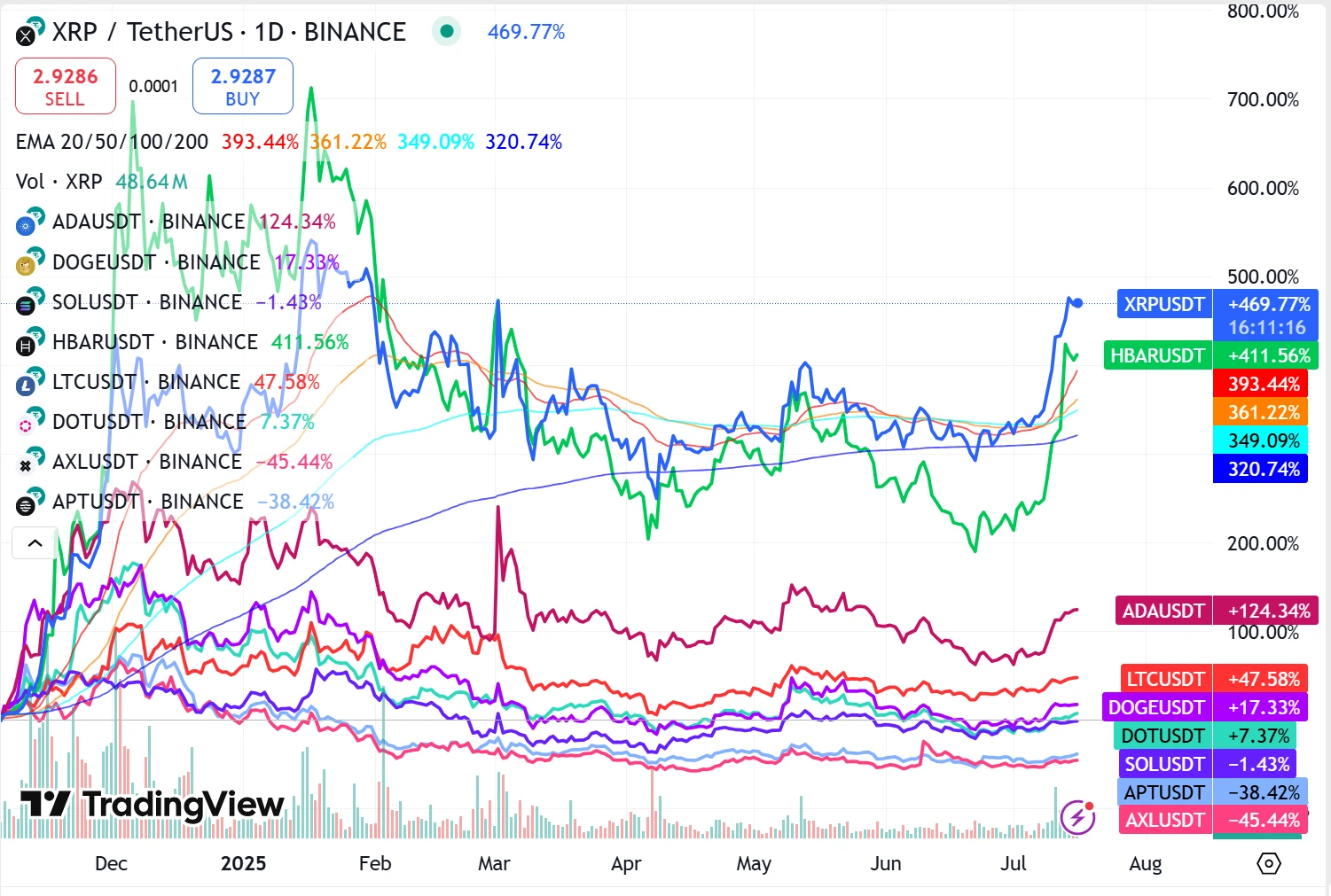
Price trend chart of altcoin ETF (daily)
Additionally, LTC and HBAR have a high probability of approval, and neither has been marked as securities, with clear compliance attributes. HBAR has also demonstrated strong anti-drawdown characteristics in multiple market shocks.
RWA track: Mapping of real assets on-chain
RWA (Real World Assets) tokenizes traditional assets such as real estate, bonds, stocks, and artworks, releasing the potential for asset liquidity, transparency, and global accessibility. This 'on-chain assetization' model provides investors with more flexible trading methods while opening new investment channels for traditional financial institutions.
With the gradual optimization of the regulatory environment, the RWA track has gained policy support. For example, Hong Kong's launch of the (Digital Asset Declaration 2.0) in 2025 explicitly supports RWA tokenization pilots, providing policy backing for its scaled development. The popular narrative surrounding RWA stems from its unique positioning in the integration of traditional finance and blockchain, combined with the continuous inflow of institutional capital, improved regulatory environment, attractive real returns, and technological maturity, making it likely to become one of the important tracks in this round of 'altcoin season'.
According to data from rwa.xyz, the largest market capitalization of RWA assets is BlackRock's BUIDL fund, in collaboration with Securitize. In addition, Exodus Movement (EXOD), Blockchain Capital (BCAP), etc., have also partnered with Securitize, but Securitize itself has not issued tokens and has collaborated with Ethena to launch a Converge project focused on RWA, which is planned to go live on the mainnet in Q2 this year. The second is Ondo, Superstate, and Centrifuge.
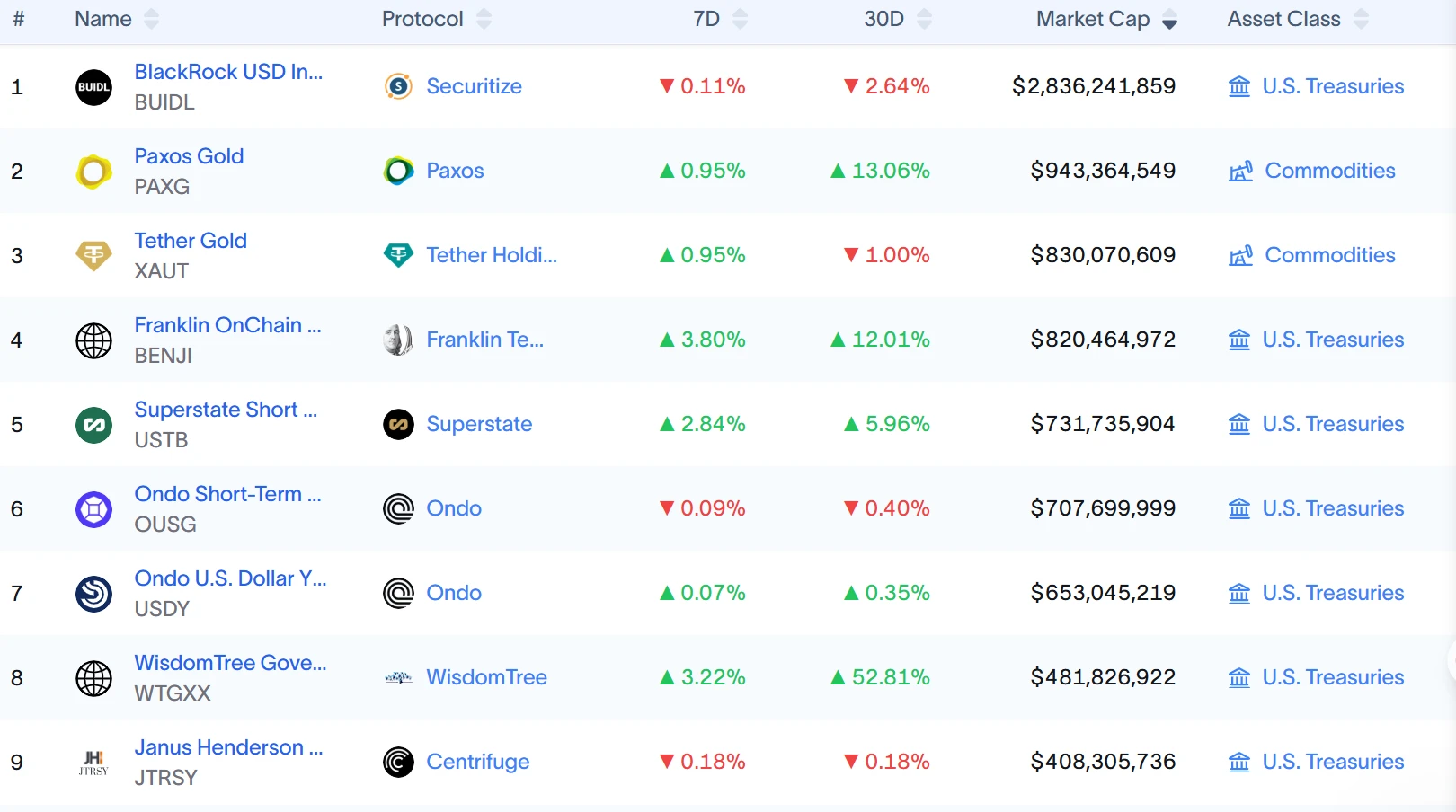
Market capitalization ranking of asset tokenization protocols
In addition, Chainlink's decentralized oracle is key infrastructure for many RWA projects. In 2024, Chainlink reached partnerships with several financial institutions including Goldman Sachs, Morgan Stanley, and Wells Fargo to provide data and settlement support for tokenized bonds and real estate asset tokenization.
Recommendation reasons
RWA naturally aligns with institutional investment preferences, serving as a 'bridge track' that combines real returns with compliance expectations, but currently, the only protocols that have formed a scale and issued tokens are Ondo (ONDO) and Centrifuge (CFG). Additionally, Chainlink (LINK), as an indispensable technological pillar of the RWA track, is also worth paying attention to.
DeFi track: Real cash flow, institutional exemption catalysis
DeFi (Decentralized Finance), as one of the core applications of blockchain, is receiving policy-level support. The US SEC plans to launch an 'Innovation Exemption' policy to pave the way for the compliant development of DeFi projects, reducing regulatory uncertainty.
In addition, DeFi chain data performance is strong. According to the industry report released by Coingecko for Q1 2025, while spot trading volumes on centralized exchanges (CEX) have generally declined, DEX spot trading volume has increased by 6.2% month-over-month, and quarterly trading volume for derivatives DEX has reached a new historical high of $799.1 billion, even exceeding the total trading volume for the entire year of 2023. This is mainly due to the outstanding performance of Hyperliquid, which has now become the eighth-ranked trading platform among all DEX and CEX derivative exchanges.
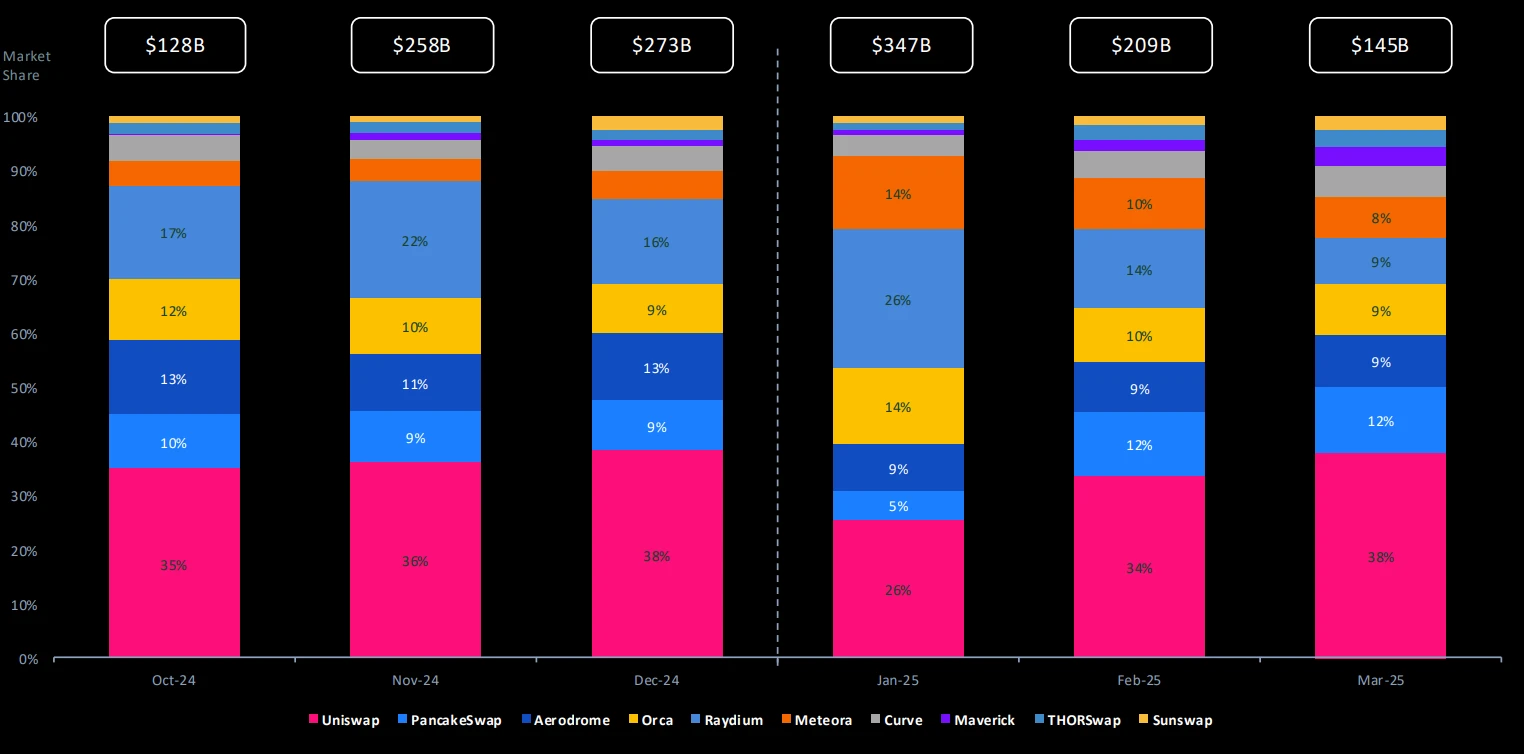
Trends in DEX spot trading volume changes
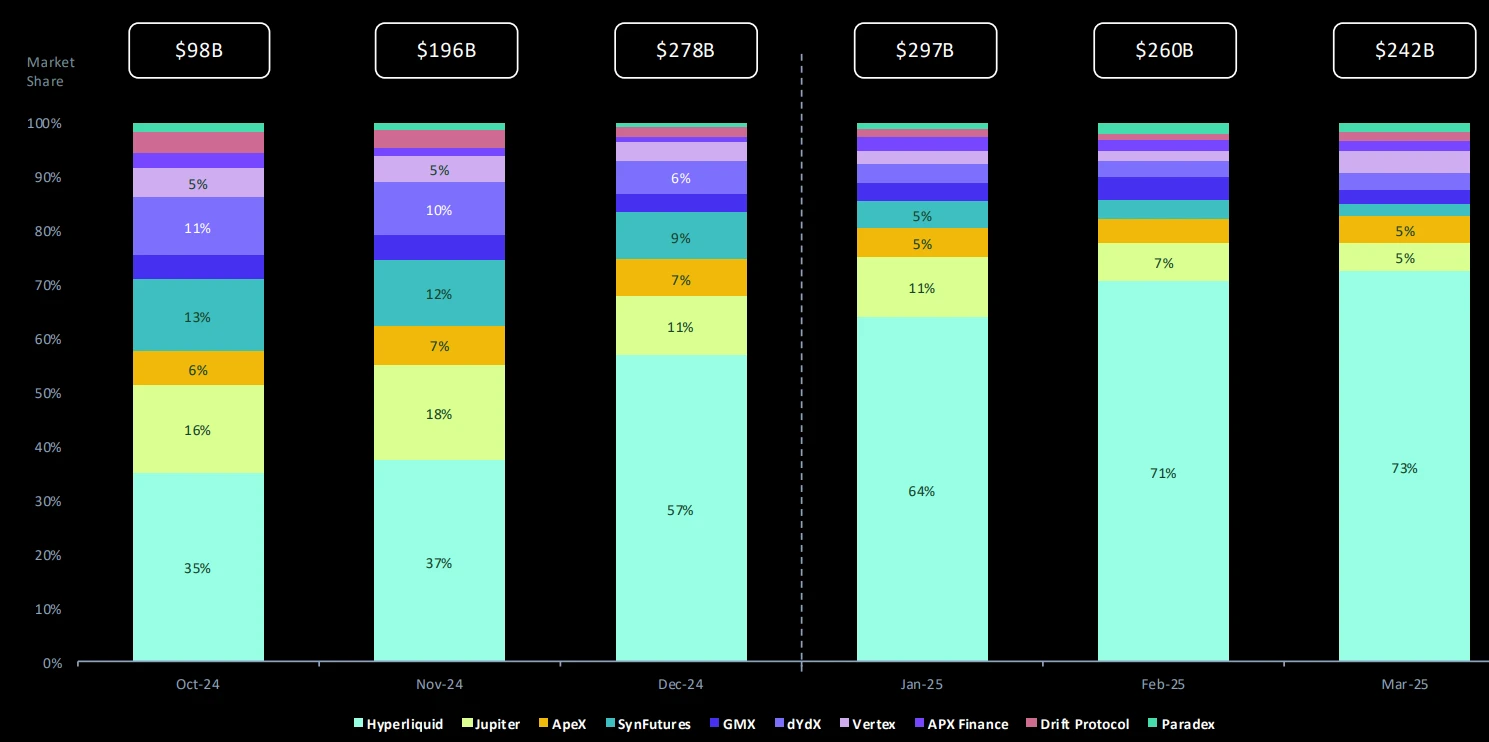
Market share of Hyperliquid
In the DeFi track, the locked value (TVL) of lending protocols accounts for the highest proportion, followed by liquid staking protocols, with leading protocols being Aave and Lido.
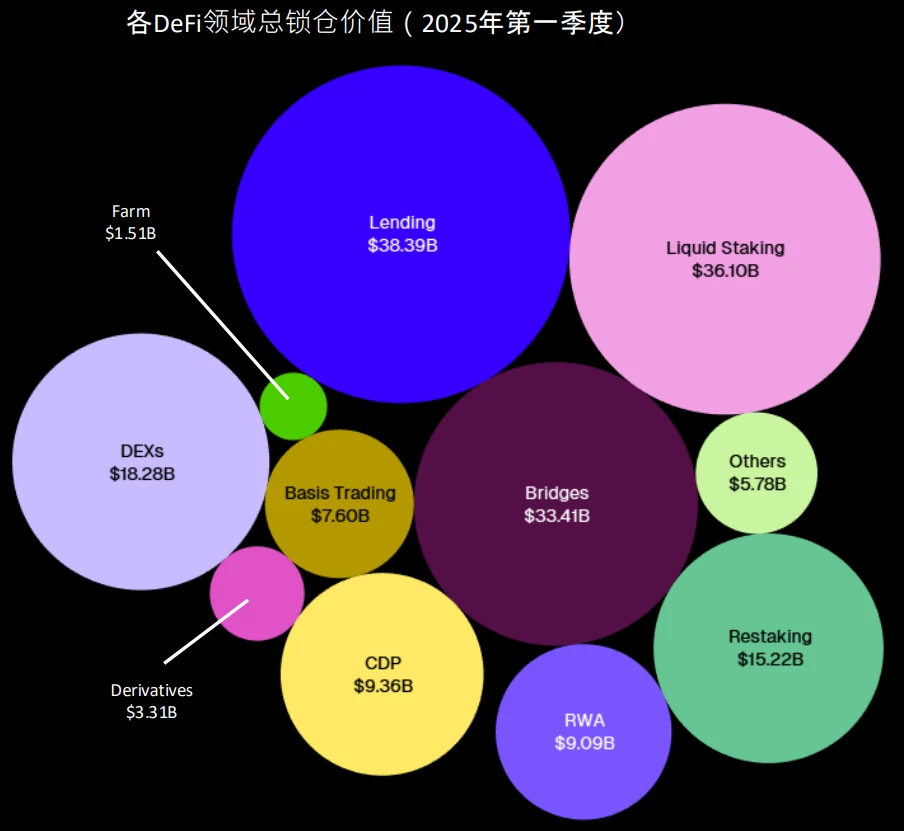
Proportion of locked-up value in DeFi track assets
In addition, DeFi projects are often the most realistic cash flow revenue-generating tracks. In a cycle where confidence is scarce, healthy finances are key factors that support the survival of projects. Further reading reference (From growth illusion to cash flow reality: When buybacks become the collective narrative of altcoins).
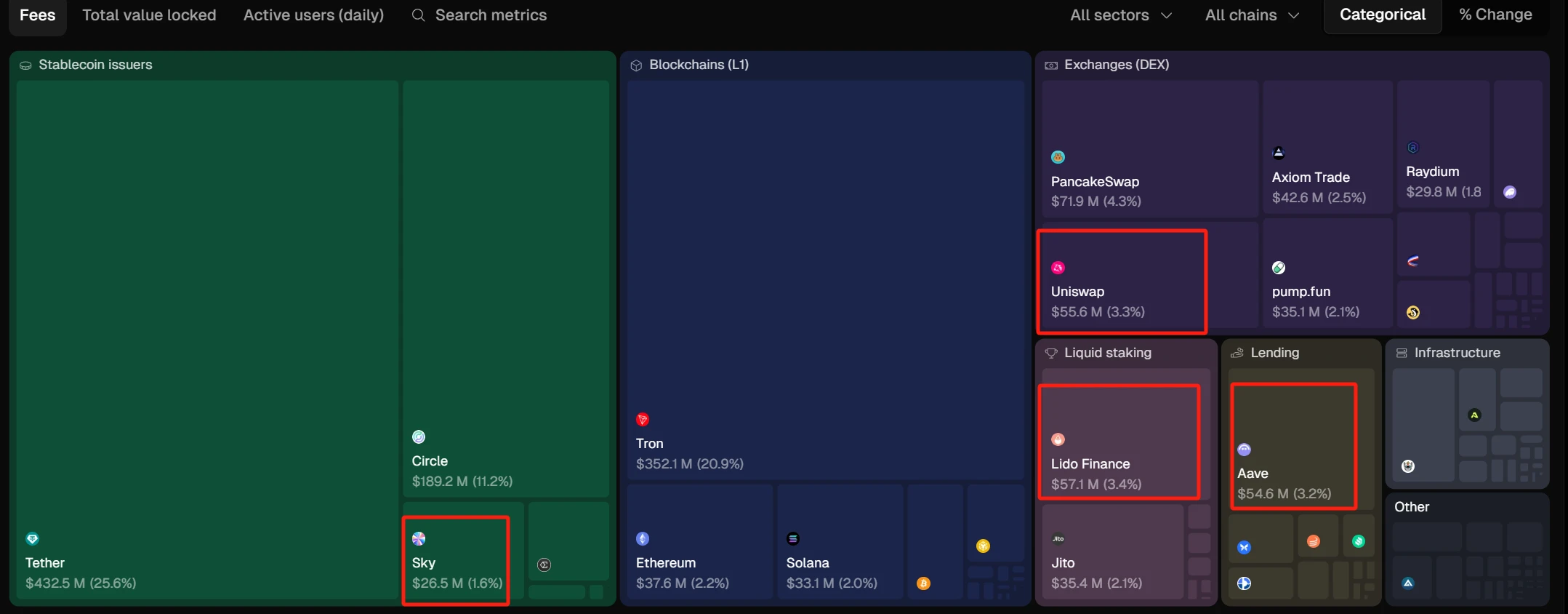
DeFi protocol fee income
There are many investment options in the DeFi track, among which DEX is one of the most profitable protocol types. The leading DEXs on different public chains have particularly outstanding performances, such as Uniswap on Ethereum, PancakeSwap on BSC, and Raydium on Solana. These DEXs, as core hubs of their respective on-chain ecosystems, directly benefit from the explosion of on-chain activities.
Taking the recent Solana ecosystem's Letbonk.fun as an example, its rapid rise has driven the price of the BONK token to surge by approximately 3 times, while also boosting the price of the leading DEX token RAY on the Solana chain to nearly double. This phenomenon indicates that the prosperity of on-chain ecosystems often amplifies the revenue potential of DEX, making it a direct beneficiary of capital overflow. However, the performance of DEX is highly dependent on the activity level of the on-chain ecosystem and market sentiment.
Recommendation reasons
With the continued warming of the Ethereum ecosystem, DeFi projects on it are most likely to benefit from capital overflow effects. As the leading lending protocol, AAVE, and the leading DEX protocol, UNI, with their mature ecological positions and stable revenue models, may become the preferred choices for capital. HYPE, as an emerging potential project (previously mentioned in the asset reserve track), shows certain investment attractiveness due to its rapid growth in the derivatives trading field.
Stablecoin track: The narrative closest to real payment implementation
The next wave of true adoption of cryptocurrencies may come from stablecoins and payments. With the introduction of the Genius Act, the regulatory framework for stablecoins is becoming increasingly clear.
The stablecoin track usually forms a synergy with the RWA and DeFi tracks. While the DeFi track encounters capital outflows and protocol deposit devaluation, RWA and CDP (Collateralized Debt Position) have achieved significant growth in TVL.
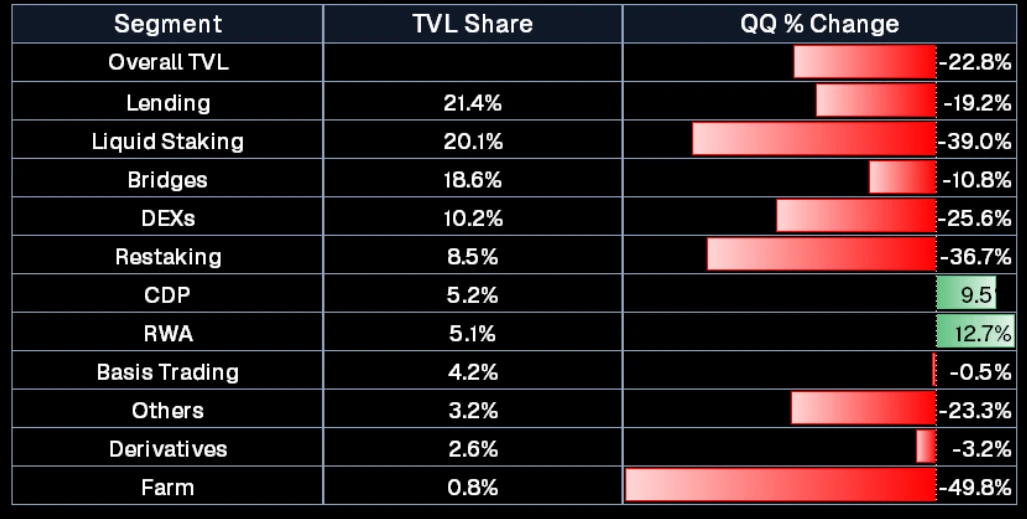
In the stablecoin sector, centralized stablecoins like USDT and USDC dominate due to their dollar reserve peg and have wide application scenarios. If one can only choose decentralized stablecoin governance tokens as investment targets, options include MKR behind DAI or ENA behind USDe.
Recommendation reasons
Sky (formerly MakerDAO) is a leader in the decentralized stablecoin sector, maintaining a healthy financial status through investments in tokenized US Treasury bonds, showcasing robust fundamentals. It is currently attempting to create its own ecological narrative through brand restructuring.
Ethena is a protocol launched in 2024, but its locked fund scale can already rival that of Sky, and it is collaborating with Securitize to launch a public chain Converge focused on RWA.
Conclusion
The true explosion of altcoin markets has never been driven by mere hype, but is a result catalyzed by capital structure, policy environment, and market narratives. When Bitcoin and Ethereum become core assets in institutional holdings, a new 'altcoin logic' quietly takes shape: coins with fundamentals, capable of telling a story, and can be caught by institutions are more likely to navigate through the fog of valuation reconstruction in the upcoming cycle and become true winners.


